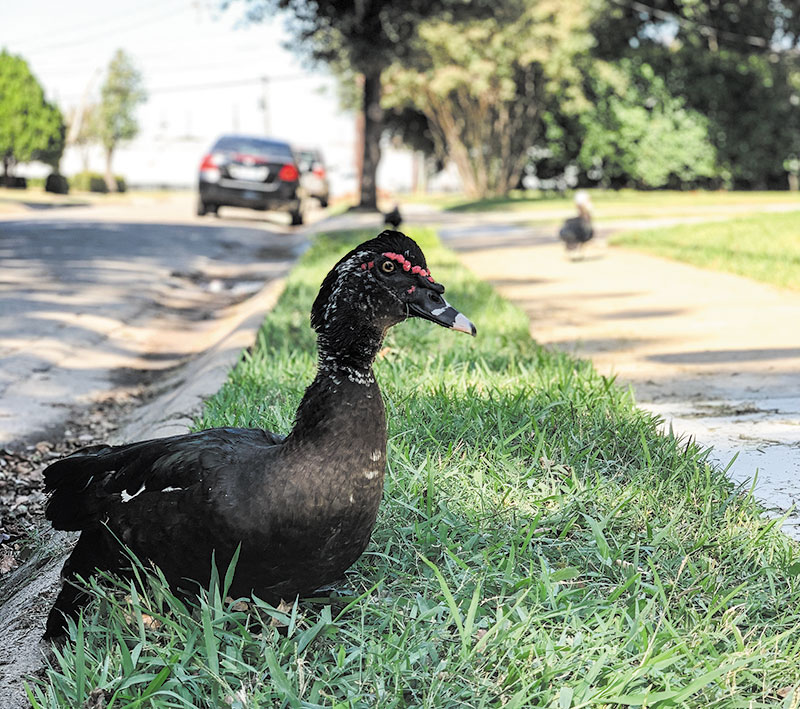Despite ‘looking like the Sith,’ a community of waterfowl gives character to an Oak Lawn gayborhood
TEXT AND PHOTOGRAPHY
ARNOLD WAYNE JONES | Executive Editor
jones@dallasvoice.com
One of the consequences of less outdoor human activity on the planet — in addition to cleaner air and a reduced carbon footprint — has been the reemergence of wildlife into urban areas. Many of us have seen pictures of monkeys on the streets of Delhi, dolphins in the canals of Venice, sheep roaming town centers in Wales.
But while cities have always sustained wildlife — from rats in sewers to pigeons on statuary and housepets on leashes — none of this unexpected influx of fauna comes as a surprise to the residents of the Maple Springs neighborhood. Starting barely a block off Maple Avenue — a stone’s throw from Parkland Hospital, around the corner from the Tin Room — this residential community with a high gay concentration of homeowners has long dealt with the omnipresence of huge gatherings of ducks.
 While beauty is in the eye of the beholder, these are not usually small, colorful mallards or snowy, flamboyant cresteds; in appearance, they seem likely to be muscovy ducks: large (almost goose-like), with a warty comb.
While beauty is in the eye of the beholder, these are not usually small, colorful mallards or snowy, flamboyant cresteds; in appearance, they seem likely to be muscovy ducks: large (almost goose-like), with a warty comb.
“They look like the Sith,” jokes Robert Cortez, who has lived here since 2015.
Cortez and his partner Gary Sanchez are some of the residents who have, if a bit begrudgingly, embraced the presence of these fowl interlopers; they’ve even raised some who were abandoned.
“It was February and they were soaking wet and the mother had already taken off,” Cortez says. “You see these pitiful little creatures — what are you gonna do?”
There were three hatchlings; two couldn’t even stand up. So the couple put them in a shoebox, got a light bulb to keep them warm and started researching how to feed ducklings. (Answer: Mealworms; when older, they’ve also fed them frozen corn and cat food.)
“Two of them lived to adulthood,” Sanchez notes, “and one of those became the neighborhood floozie.”
That’s pretty believable — there are lots of ducks. They tend to travel in clusters. And they aren’t shy.
“They aren’t afraid of anyone!” jokes Larry Lane, a longtime resident. Lane remembers when, attracted by a nearby spring (hence the neighborhood’s moniker), ducks first started to congregate. After a house abutting the springs burned down, the brace of ducks ventured into yards, eventually walking down the streets and sidewalks like they owned the place.
At first, Lane concedes, they were charming — a defining element to the community. In part, that’s because the local raccoons would eat eggs and control the duck population. But a blight killed off many of the raccoons, leaving the ducks without natural predators. In the last few years, they have become more bold… and, Lane admits, more annoying.
“They have torn up my grass,” he sighs.
“There is some duck drama — it is a polarizing issue in the neighborhood,” admits Sanchez.
Many residents tolerate them… and more. Gary Riggs, another homeowner, has a backyard swimming pool in which he will often have to chase away some of the paddling visitors. But recently, he has noticed small nests popping up on his property filled with duck eggs, which eventually become hatchlings. You can still find the babies quacking through the streets, though, the mama leading her offspring down the road.
Still, even many of those who find them troublesome wish no ill will on the birds and acknowledge that their presence makes for a distinctive feature in the community. One neighbor has even painted her front door with pictures of the ducks, incorporating actual feathers into the design — a fitting acknowledgment that the ducks of Maple Springs are residents like anyone else.













